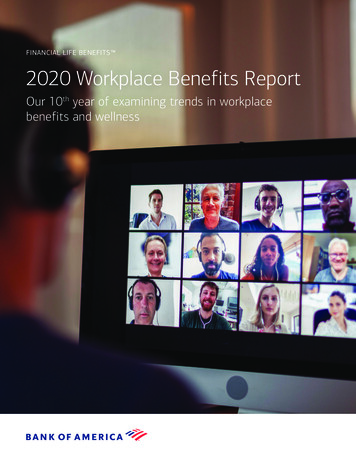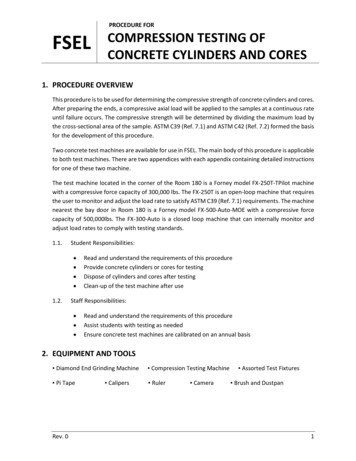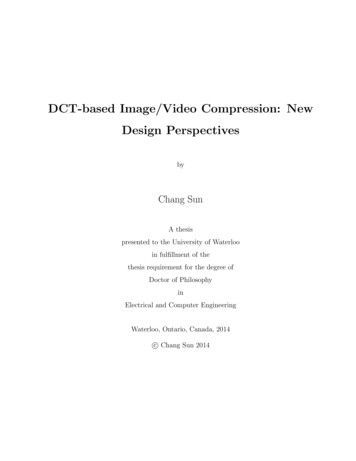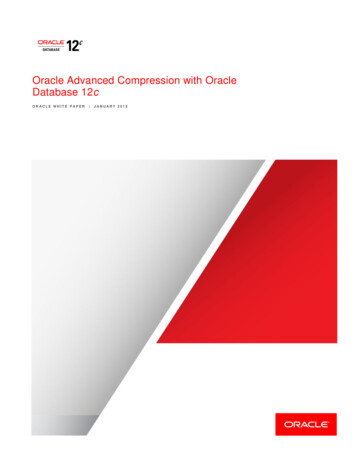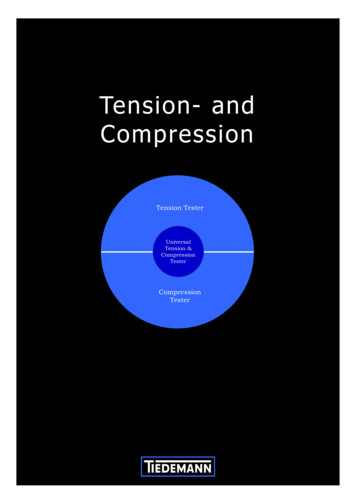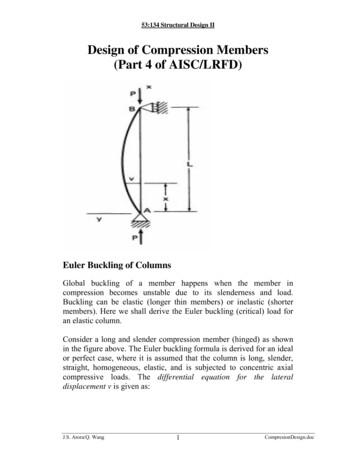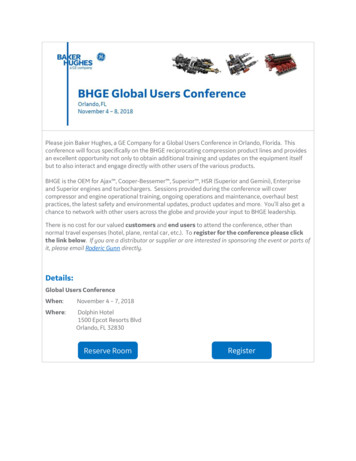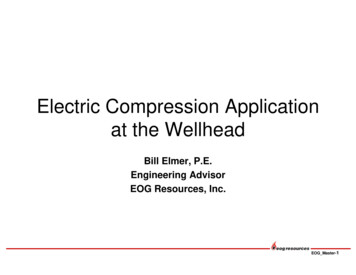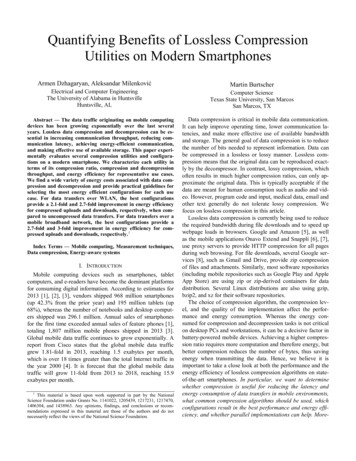
Transcription
Quantifying Benefits of Lossless CompressionUtilities on Modern SmartphonesArmen Dzhagaryan, Aleksandar MilenkovićMartin BurtscherElectrical and Computer EngineeringThe University of Alabama in HuntsvilleHuntsville, ALComputer ScienceTexas State University, San MarcosSan Marcos, TXAbstract — The data traffic originating on mobile computingdevices has been growing exponentially over the last severalyears. Lossless data compression and decompression can be essential in increasing communication throughput, reducing communication latency, achieving energy-efficient communication,and making effective use of available storage. This paper experimentally evaluates several compression utilities and configurations on a modern smartphone. We characterize each utility interms of its compression ratio, compression and decompressionthroughput, and energy efficiency for representative use cases.We find a wide variety of energy costs associated with data compression and decompression and provide practical guidelines forselecting the most energy efficient configurations for each usecase. For data transfers over WLAN, the best configurationsprovide a 2.1-fold and 2.7-fold improvement in energy efficiencyfor compressed uploads and downloads, respectively, when compared to uncompressed data transfers. For data transfers over amobile broadband network, the best configurations provide a2.7-fold and 3-fold improvement in energy efficiency for compressed uploads and downloads, respectively.1Index Terms — Mobile computing, Measurement techniques,Data compression, Energy-aware systemsI. INTRODUCTIONMobile computing devices such as smartphones, tabletcomputers, and e-readers have become the dominant platformsfor consuming digital information. According to estimates for2013 [1], [2], [3], vendors shipped 968 million smartphones(up 42.3% from the prior year) and 195 million tablets (up68%), whereas the number of notebooks and desktop computers shipped was 296.1 million. Annual sales of smartphonesfor the first time exceeded annual sales of feature phones [1],totaling 1,807 million mobile phones shipped in 2013 [3].Global mobile data traffic continues to grow exponentially. Areport from Cisco states that the global mobile data trafficgrew 1.81-fold in 2013, reaching 1.5 exabytes per month,which is over 18 times greater than the total Internet traffic inthe year 2000 [4]. It is forecast that the global mobile datatraffic will grow 11-fold from 2013 to 2018, reaching 15.9exabytes per month.1This material is based upon work supported in part by the NationalScience Foundation under Grants No. 1141022, 1205439, 1217231, 1217470,1406304, and 1438963. Any opinions, findings, and conclusions or recommendations expressed in this material are those of the authors and do notnecessarily reflect the views of the National Science Foundation.Data compression is critical in mobile data communication.It can help improve operating time, lower communication latencies, and make more effective use of available bandwidthand storage. The general goal of data compression is to reducethe number of bits needed to represent information. Data canbe compressed in a lossless or lossy manner. Lossless compression means that the original data can be reproduced exactly by the decompressor. In contrast, lossy compression, whichoften results in much higher compression ratios, can only approximate the original data. This is typically acceptable if thedata are meant for human consumption such as audio and video. However, program code and input, medical data, email andother text generally do not tolerate lossy compression. Wefocus on lossless compression in this article.Lossless data compression is currently being used to reducethe required bandwidth during file downloads and to speed upwebpage loads in browsers. Google and Amazon [5], as wellas the mobile applications Onavo Extend and Snappli [6], [7],use proxy servers to provide HTTP compression for all pagesduring web browsing. For file downloads, several Google services [8], such as Gmail and Drive, provide zip compressionof files and attachments. Similarly, most software repositories(including mobile repositories such as Google Play and AppleApp Store) are using zip or zip-derived containers for datadistribution. Several Linux distributions are also using gzip,bzip2, and xz for their software repositories.The choice of compression algorithm, the compression level, and the quality of the implementation affect the performance and energy consumption. Whereas the energy consumed for compression and decompression tasks is not criticalon desktop PCs and workstations, it can be a decisive factor inbattery-powered mobile devices. Achieving a higher compression ratio requires more computation and therefore energy, butbetter compression reduces the number of bytes, thus savingenergy when transmitting the data. Hence, we believe it isimportant to take a close look at both the performance and theenergy efficiency of lossless compression algorithms on stateof-the-art smartphones. In particular, we want to determinewhether compression is useful for reducing the latency andenergy consumption of data transfers in mobile environments,what common compression algorithms should be used, whichconfigurations result in the best performance and energy efficiency, and whether parallel implementations can help. More-
over, we want to develop a framework for determining if compression should be used and what configuration will providethe best results.In this article, we perform a comparative, measurementbased study of the most recent versions of several popularcompression utilities, including gzip, lzop, bzip2, xz, pigz (aparallel implementation of gzip) and pbzip2 (a parallel implementation of bzip2) on Google’s Nexus 4 smartphone. Foreach utility, we analyze the effectiveness of all supportedcompression levels. We examine several performance metrics,including the compression ratio and the compression and decompression throughput. Using our experimental setup forenergy measurements, we study the amount of energy consumed by compression and decompression tasks and report theenergy efficiency.We evaluate the compression utilities in three typical usagescenarios. LOCAL involves compression and decompressiontasks performed locally on the smartphone. WLAN and CELLinvolve compression tasks that stream data to and from a remote server over a secure communication channel. WLAN usesa wireless LAN interface and CELL uses a mobile broadbandnetwork. We also devise an analytical model for estimatingthe effectiveness of individual utilities in the WLAN and CELLscenarios. The model relies on parameters from the LOCALexperiments and parameters characterizing the network interface.Our main findings are as follows. The throughput and energy efficiency of compressionutilities varies widely across different utilities andcompression levels, often spanning an order of magnitude. We identify combinations of the utilities andcompression levels that result in the best throughputand energy efficiency for typical use scenarios. In the LOCAL experiments, pigz with compressionlevel -1 and lzop -1 to -6 achieve the best compressionthroughput and energy efficiency. lzop achieves thebest decompression throughput and efficiency. In the WLAN experiments, compressed uploads withgzip with a low compression level perform best, providing over twice more energy efficient transfers compared to uncompressed uploads. For downloads, pigzwith compression levels -6 to -9 achieves the best decompression throughput and energy efficiency, providing 2.7 times more energy efficient transfers compared to uncompressed downloads. In the CELL experiments, compressed uploads withbzip2 perform best, with up to 2.7 times more energyefficient transfers compared to uncompressed uploads.For decompression tasks, xz with the highest compression levels achieves the best decompression throughputand energy efficiency, providing up to 3 times moreenergy efficient transfers compared to uncompresseddownloads.The importance of lossless compression on consumer devices has been widely recognized [9]. This article complements our earlier study on Linux-based mobile developmentplatforms with limited connectivity [10], [11] and other studies that were conducted about a decade ago [12], [13]. Incontrast to these prior studies, here we consider the most recent compression utilities including some with parallel implementations, our setup supports more accurate energy measurements, and we use a state-of-the-art smartphone with fourprocessor cores and wireless and cellular communication interfaces. In addition, we study the performance and energyefficiency for all supported compression levels in three typicaluse scenarios with representative datasets.The rest of this paper is organized as follows. Section IIpresents the experimental setup, including the smartphone(II.A), the measurement setup (II.B), the compression utilities(II.C), and the dataset (II.D). Section III explains the measuredand derived metrics used (III.A) as well as the experiments(III.B). Section IV discusses the results. Section V summarizesour findings and draws conclusions.II. EXPERIMENTAL SETUPA. SmartphoneWe use Google’s Nexus 4 smartphone [14] as the targetplatform. The Nexus 4 is powered by a Qualcomm Snapdragon S4 Pro (APQ8064) system-on-a-chip that features a quadcore ARM processor running at up to 1.512 GHz clock frequency. The smartphone has 2 GBytes of LPDDR2 RAMmemory and 16 GBytes of built-in internal storage. It supportsa range of connectivity options including WLAN 802.11n,Bluetooth 4.0, and several cellular network protocols.Fig. 1. Nexus 4 prepared for energy measurementsTo prepare the smartphone for energy profiling, its underlying plastic shield was removed to reveal connections on itsmotherboard and daughterboards as shown in Fig. 1. We replaced the smartphone’s battery with power connectors coming from a battery simulator. During measurements, connectors to the smartphone components such as the LCD display,touchscreen, USB and others can be removed to reduce theimpact of these components on the consumed energy.The smartphone’s Android (Jelly Bean) operating system isupgraded to (a) support common compression/decompressionutilities not readily supported on Android, and (b) to automateperformance and energy measurements. We flashed the smartphone with CyanogenMod version 10.2 [15], an open sourceoperating system for smartphones and tablet computers based
on official releases of Android that include third-party code.The included compression utilities are gzip, bzip2, lzop, andxz. The parallel versions of gzip and bzip2, pigz and pbzip2,respectively, were compiled on the smartphonne.B. Measuring setupFig. 2 shows a block diagram of our setup ffor measuring theenergy consumed on the smartphone. The maain components ofthe setup are an NI PXIe-4154 battery simuulator, the smartphone, and a workstation. The battery simulaator, a specializedprogrammable power supply, resides inside aan NI PXIe-1073chassis that is connected to an MXI-Expreess Interface cardinside the workstation. The battery simulatoor is used (a) topower the smartphone through probes on chaannel 0 by providing 4.1 volts, thus bypassing the actual smmartphone battery,and (b) to measure the current drawn by the ssmartphone whilerunning applications. The battery simulator samples the current with a configurable sampling rate of up to 200,000 samples per second and a sensitivity of 1 µA.Fig. 2. Block diagram of the hardware setup for eenergy profilingclient server program that includes thet following components:a client, which runs on the workstatiion; a server, which runs asa background process on the workstation; and a daemon,b can connect over a USBwhich runs on the smartphone. adblink or over a WLAN interface.To run a compression or a deecompression task on thesmartphone, a sequence of adb commmands is launched fromthe workstation to be executed on thhe smartphone. The execution of a compression/decompression task is typically preceded and trailed by a 5 second deelay (head and tail delays)during which the smartphone is in ana idle state. The compression/decompression task is wrappeed by commands that taketime stamps corresponding to the momentsmwhen the task islaunched and finishes. These times are used to determine thedentify the appropriate curtask execution time as well as to idrent samples logged on the workstattion to calculate the energyconsumed by the task.Fig. 3 shows the measured curreent drawn by the Nexus 4during execution of a script that commpresses an input file usinggzip -6 and outputs the result to /ddev/null. The head and taildelays are 5 seconds each and thhe compression task takesroughly 17 seconds. The top graphh in the figure shows thecurrent drawn during the experimentt as it is used in our energycalculations. The bottom graph showws the filtered signal, provided here only to enable easier vissual inspection by a humanof the changes in the current drawn during program execution.The Nexus 4 with all unnecessary services turned off (LCDdisconnected, GPS and WLAN intterfaces turned off) draws 11 mA (IIDLE 11 mA). The start of the compression task ismarked by a step increase in the currrent drawn of 270 mA to280 mA, the current remains high duuring the compression, andgoes back to the idle level after thhe compression has terminated. The number of samples durinng the execution of a compression utility is n T.C SF, wheere T.C is the compressiontime for a given file and SF is the sampling frequency of thebattery simulator (with respect to the number of recordedmed (ET.C) is calculated assamples). The total energy consumshown in equation (1), where VBS iss the supply voltage on thebattery simulator (VBS 4.1 V) and each Ij is a current sampleduring compression.n1(1)ET . C V BS SF I jj 1ET .C ( 0 ) ET .C I idle V BS T .C(2)In addition to ET.C, we also calculaate the energy overhead ofthe compression task alone, ET.C(0)), which excludes the energy needed to run the platform whenn idle. This overhead is calculated as in equation (2).Fig. 3. Current drawn by the Nexus 4 when executiing the gzip utilityThe workstation runs our custom programm called mLViewPowerProfile. This program interfaces (a) thhe smartphone tomanage activities and applications on the smmartphone that arebeing profiled and (b) the battery simulator tto collect the current samples. The communication with the smmartphone is carried out over the Android Debug Bridge (addb) [16]. adb is aC. Compression UtilitiesTABLE I lists the six lossless commpression utilities we havestudied along with the supported rannge of compression levels.We chose the relatively fast gzip utility and the slower butbetter compressing bzip2 utility beecause of their widespreaduse. lzop is included because of itss high speed. xz is gainingground and is known for its high coompression ratio, relatively
slow compression, and fast decompression. As many modernsmartphones include multicore CPUs, we also included pigzand pbzip2, which are parallel versions of gzip and bzip2, respectively. All of these utilities operate at byte granularity andsupport a number of compression levels that allow the user totrade off speed for compression ratio. Lower levels favorspeed whereas higher levels result in better compression. gzip[17] implements the deflate algorithm, which is a variant ofthe LZ77 algorithm [18]. lzop [19] uses a block-based compression algorithm that favors speed over compression ratioand requires very little memory for decompression. The implementation ported on our test device supports only compression levels -1 to -6. bzip2 [20] implements a variant of theblock-sorting algorithm described by Burrows and Wheeler(BWT) [21]. xz [22] is based on the Lempel-Ziv-Markov chaincompression algorithm (LZMA) developed for 7-Zip [23].pigz [24] is a parallel version of gzip for shared memory machines that is based on pthreads. It breaks the input up into 128kB chunks and concurrently compresses multiple chunks. Thecompressed data are outputted in their original order. Decompression operates mostly sequentially. pbzip2 [25] is a multithreaded version of bzip2 that is also based on pthreads. It worksby compressing multiple blocks of data simultaneously. Theresulting blocks are then concatenated to form the final compressed file, which is compatible with bzip2. Decompressionis also parallelized.TABLE ICOMPRESSION onlevels1 – 9 (6)1 – 9 (3)1 – 9 (9)0 – 9 (6)1 – 9 (6)1 – 9 (9)VersionNotes1.61.031.0.65.1.0a2.31.1.6DEFLATE (Ziv-Lempel, Huffman)LZO (Lempel-Ziv-Oberhumer)RLE BWT MTF RLE HuffmanLZMA2Parallel implementation of gzipParallel implementation of bzip2TABLE IIDATASETiType12345text (txt)exec (so)image (bmp)table (csv)code (tar)Raw esProject Gutenberg Works of Mark TwainOpen source web content engine libraryAn image of Earth from spaceActivity data from a health monitorPerl 5.8.5 source codeD. DatasetsIn selecting the data to evaluate the effectiveness of thecompression utilities, we compiled a set of diverse input filesthat are representative of mobile computing environments.The input file formats include text, an executable, an image, afile with comma-separated values from a wearable healthmonitor, and source code. TABLE II gives the input files, theirtypes, size in bytes, and a description. The files are mergedinto a single archive file (tar) that is used as an input for thecompression utilities.III. METRICS AND EXPERIMENTSA. MetricsTABLE III summarizes the metrics used as well as their definitions.Compression ratio. We use the compression ratio(CR US/CS) to evaluate the compression effectiveness of anindividual utility and its levels of compression.Performance. To evaluate the performance of individualcompression utilities and compression levels, we measure thetime to compress the raw input file (T.C) and the time to decompress (T.D) a compressed file generated by that utilitywith the selected compression level. Each compression anddecompression task is repeated three times and the averagetime is calculated. Instead of reporting the execution timesdirectly, we report the compression and decompressionthroughput (Th.C and Th.D) expressed in megabytes persecond (Th.C US/T.C and Th.D US/T.D).TABLE IIIMETRICSSymbolDescriptionUSCSCRT.C [T.D]T.UUP[T.UDW]Uncompressed file sizeCompressed file sizeCompression ratioTime to [de]compressTime to upload [download] the uncompressed fileTotal energy for[de]compressionTotal energy for upload [download] of theuncompressed fileOverhead energy essed upload[download] throughput[De]compressionenergy efficiency[De]compressionoverhead energy suredJMeasuredJMeasuredJET.C – Iidle VBS T.C[ET.D – Iidle VBS T.D]US/T.C [US/T.D]MB/sMB/sMB/JMB/JUS/T.UUP[US/T.UDW]US/ET.C [US/ET.D]US/ET.C(0)[US/ET.D(0)]The derived throughput captures the efficiency of datatransfers from the user’s point of view – users produce andconsume raw data and care more about the time it takes totransfer data than about what approach is used internally tomake the transfer fast. In addition, this metric is suitable forevaluating networked data transfers and comparing compressed and uncompressed transfers.Energy efficiency. For each compression task with a selected compression level, we calculate the total energy forcompression (ET.C) using the method described in Eq. (1) aswell as the total energy for decompression (ET.D). For eachcombination of a compression utility and a compression level,three measurements are conducted and the average energy iscalculated. Instead of reporting the energy directly in joules,we rep
n NI PXIe-1073 ess Interface card r is used (a) to annel 0 by provid-artphone battery, martphone while samples the cur-to 200,000 sam-nergy profiling ng the gzip utility called mLView-e smartphone to artphone that are o collect the cur-artphone is car-b) [16]. adb is a client server prog


